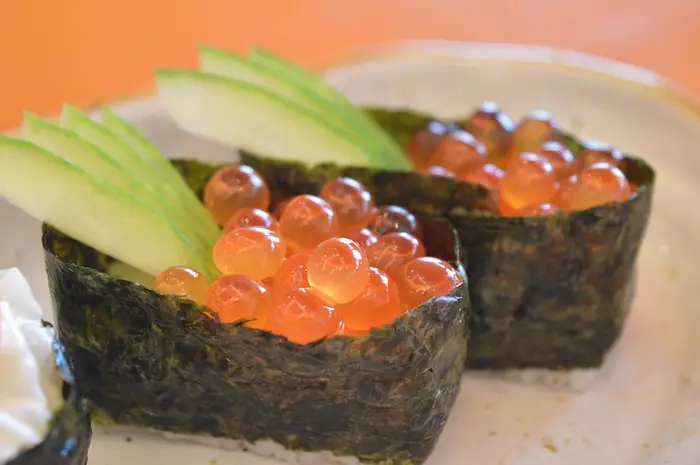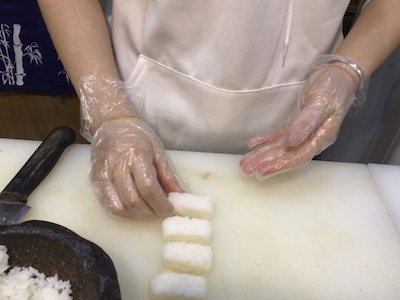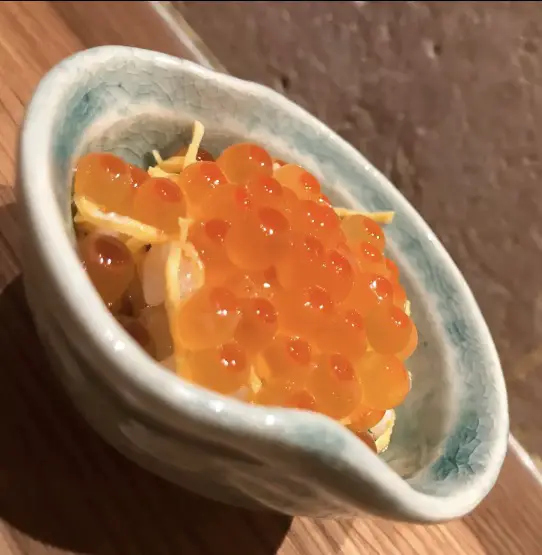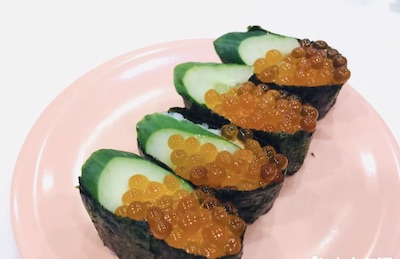We are reader supported. When you purchase through links on our site, we may earn an affiliate commission. Also, as an Amazon affiliate, we earn from qualifying purchases.

If you haven’t eaten salmon roe (ikura) before, you may feel slightly intimidated by the orange balls that sit pretty on a clump of rice bed or used as a garnish on sushi rolls. As you take a bite, the rich and savory flavors burst into your mouth, making you feel ecstatic.
The delicious orange balls that emit a sweet and lingering flavor into your mouth are called salmon roe or ikura in Japanese. These are eggs of salmon fish, which is not a native of Japan, yet this delicacy holds a special place in Japanese cuisine.
Interestingly, salmon roe sushi was not popular before the 1980s because the locals did not eat salmon during that time. It was only after the 1980’s Norwegian marketing campaign that salmon became a part of Japanese food.
The term ‘ikura’ is believed to have been derived from ‘ikra’, a Russian word that means fish eggs. However, ikura today is used to strictly refer to the eggs of salmon fish. Despite its popularity, it’s hard to find quality salmon eggs as most of them are shipped frozen.
Those who are lucky to have tasted fresh salmon eggs know that they have a slightly briny flavor like that of the sea and taut skin. They are spherical in shape and filled with savory juices. Freezing eggs make them sag and juices may leak out when they are shipped or thawed at home.
Contents
Transforming Salmon Roe To Caviar (Preparing Ikura)
If you are lucky to live in a region where you can buy fresh salmon roe out of the sea. However, you cannot eat them in the raw form because they must be processed to transform into caviar. One salmon skein can weigh around a pound and it can give you 16 ounces of caviar. Here are the steps to cure salmon roe to be used in sushi and other dishes.
What you will need:
- 1 salmon skein or sack
- 1 cup kosher salt
- 3 liters of warm water
Instructions
Take a medium sized bowl (glass or stainless steel) and add water and salt. Stir until salt dissolves completely.
Now, rinse the sack containing eggs under cool tap water to get rid of any residual blood. A thin membrane holds the eggs together inside the sack.
Place the entire skein into the brine solution in the bowl. Within a few minutes, the eggs will turn from clear orangish-red color to a hazy orange hue. This is due to salt water reacting with the membrane.
Make sure the salmon skein is completely submerged inside the brine solution and let it sit for at least 30 minutes.
Now, remove the sack from the brine solution and place it in another bowl containing warm water. Wash off the brine solution and remove the thin membrane using your fingers. Keep the brine solution for later use.
Inside the sack, you will find many finer membranes holding the eggs together. The eggs must be washed several times in order to remove these thin membranes.
A sieve or skimmer can help you in the process. When you have completely washed the eggs, submerge them again in the brine solution and the color will turn clear orange.
Strain out the eggs and store in a glass jar. The fish eggs can last for 7-14 days if refrigerated at a temperature of 1°C / 34°F or below. Do not keep them in the freezer or else the texture will be spoiled.
Now that your homemade salmon roe or ikura is ready, you can go ahead and make your own sushi or use the eggs in a variety of other delicacies.
Salmon Roe Sushi (Ikura ) With Avocado And Salmon
What you will need
- 2 cups of seasoned sushi rice
- Sushi-grade salmon
- A ripe but firm avocado
- Nori seaweed
- Salmon Roe (Ikura)
- Pickled ginger
- Wasabi
- Soy sauce
First, you will need to cook and season sushi rice using short-grain Japanese rice. I have created step by steps instructions to take the guesswork out of cooking and seasoning sushi rice, just click here for details.
Next, you will need to prepare the fillings. Cut the avocado into half, remove the pit and scoop out the flesh. Make thin slices with a sharp Japanese sushi knife and sprinkle some lemon juice on it to prevent oxidation.
Make thin sashimi style strips of salmon, approximately 2 inches thick and keep them aside.
Now, place the bamboo mat on a working area and cover it with a plastic cling film. Put the Nori sheet over the plastic and cover it with a layer of sushi rice, press gently to ensure rice sticks to the seaweed.
Flip the Nori sheet to make it upside down and now arrange the salmon strips over the seaweed and then place avocado slices on it.
Lift the bamboo mat from one end and start rolling to make a compact cylinder shape. Press gently using the bamboo mat to ensure that the fillings hold each other well.
Take a sharp Japanese knife, moisten the blades and cut the roll into 6-8 pieces. Garnish each piece with ikura on the top for a crunchy and savory flavor.
Salmon Roe Temari Sushi Recipe Using Smoked Salmon
If you don’t like the taste of Nori seaweed and would like to do away with it then here’s a sushi recipe worth trying. I like to call this a nigiri sushi with a twist, so read on.
What you will need:
- Vinegared sushi rice
- Smoked salmon pieces
- Shiso leaves
- Salmon Roe (Ikura)
- Plastic cling film
Instructions
Cook sushi rice at least 30 minutes before you start making sushi, so that the rice is at room temperature. You can find instructions on how to perfectly cook and season sushi rice here.
To shape the rice bed, take about 50 g of seasoned rice and place it on a plastic cling film. Shape it into a ball, but slightly flatten the bottom and top to make it easier to rest the toppings.
Now place a slice of smoked salmon over the bed of rice and also put shiso leaf (cut into half) over the ball. Cover it with the plastic film and apply gentle pressure using your fingers to blend the rice and toppings together so that they don’t fall out.
Now, remove the cling film and garnish the rice balls with some salmon roe on the top. Serve with soy sauce and wasabi.
Salmon Roe (Ikura) Gunkan Sushi

Some people prefer making gunkan or battleship sushi using fresh salmon eggs because they are delicious even without any added flavors. However, in this recipe, I will show you how to marinate salmon eggs to enhance the taste.
For the marinade, we will add equal parts of sake (rice wine) and shoyu (soy sauce). Add dry eggs to the solution and let them sit inside the refrigerator overnight.
Another method I like trying at home is to take a few spoons of salmon roe eggs in a bowl, add some Japanese mayo sauce as per your liking and a pinch of wasabi for the extra kick. Mix it together and let the mixture sit for 15-20 minutes before you use it in your salmon roe gunkan sushi.
After you are done with marinating the ikura, prepare the sushi rice by cooking it to perfect consistency and then flavoring it with rice vinegar, sugar, and salt following these instructions.
Cut the Nori sheet into three equal and long strips to create the battleship structure around a bed of rice.
Take a small golf ball-shaped sushi rice in your palm and use your fingers to create an oval base. Use the Nori strip to wrap around the rice bed and seal the edges with a few drops of water.

Now take a spoonful of marinated salmon roe (ikura) and place over the bed of rice. You may garnish with a shiso leaf or cucumber and your salmon roe gunkan sushi is ready to serve.
Different Types Of Salmon Roe (Ikura)
To make one of the above salmon roe sushi recipes, you will first need to buy the fish eggs from an Asian grocery store or online store like Amazon.
Whether you buy from a local grocer or online, you will find several types of salmon roe to choose from. Sushi experts from Japan differentiate the fish eggs based on the type of fish – chum salmon is considered as the most prized possession and the other two common varieties are king salmon and sockeye salmon.
The salmon eggs also differ according to the place of origin, such as the lake (farmed) or sea (wild). Another differentiating factor is the age of salmon. You can spot the effect of these factors in the pigment color and size of the caviars extracted from different salmon fish.
Here are various types of salmon roe you can find at grocery stores or online:
Alaskan Salmon Roe, also known as malossol is one of the highly-rated fish eggs of all and their size varies from medium to large. The color is reddish-orange and a small eye can be seen. The bead sized eggs are full of oily brine and they burst into the mouth giving you subtle flavors of the fish.
Salmon Roe (Keta Caviar) is known by its characteristic shining eggs and the outer shell is firm and translucent. They contain a sweet and savory juice inside the golden-orange covers that glisten when sun’s rays fall on them.
Coho Salmon Roe is extracted from the fish found in the wild in Canada. Besides their rich sea flavor, the eggs are also filled with minerals, vitamins, and acidic oil. Reddish-orange in color, these bead shaped eggs are translucent and filled with brine solution.
Pink Trout Roe Caviar comes from the pink trout that are farmed in controlled conditions. The eggs are medium-sized and they have a subtle flavor without being too bold or fishy. The orange-colored beads are identified by their orange-red eye.
Interesting Facts About Salmon Roe(Ikura)

Appearance
Salmon roe are brightly colored orange-red eggs that are slightly larger in size than masago (capelin roe) and tobiko (flying fish roe). They are extremely delicate in texture hence must be handled with great care. Most of the salmon caviar come from Alaska and they are exported to Japan.
Taste
For a beginner, eating ikura can be a unique and intriguing experience. The outer skin of the eggs may offer a bit of resistance while biting. As they pop inside the mouth, you can relish the juice that is salty and savory. The eggs taste a lot like the sea
While you can use salmon roe as masago and tobiko in making sushi rolls, they are often enjoyed as a standalone delicacy with raw quail eggs to accentuate the umami factor.
Season
Unlike the difference in the flesh of wild and farmed salmon, their eggs don’t differ much in taste. As a relatively new fish, there is not much customs or rules regarding the best quality ikura. You can find ikura from farmed salmon throughout the year. However, the eggs must be harvested at the right time because the skin can become tough in older eggs.
If you are looking for eggs from wild salmon, the best time to harvest is mid-Fall season. The eggs are in the optimal condition during this time – softest and largest.
Biggest Area Of Production In Japan
Hokkaido, situated in the northernmost region of Japan is the largest producer of salmon roe (ikura), followed by the Sanriku area. During this time, the salmons swim back to the rivers from the seas to lay their eggs.
When a salmon releases eggs, it does so inside an egg pouch (sujiko). Some people have no idea where the salmon roe actually come from. They are extracted from the fish like a large organ and then prepared in a brine solution according to the method mentioned above.
5 Tips To Select The Best Quality Ikura
#1. Red caviars are typically sold in sealed glass jars or cans. I suggest that you buy them by the pound and prefer the glass jar over the cans. You can clearly see the condition of the salmon eggs inside a glass jar but the contents inside a can may contain high amounts of salt and preservatives.
#2. Look for signs that tell whether the eggs are good or bad in quality. Ikura should be sturdy and eggs must not be cracked. The sizes may vary slightly. If they all look the same, this may be a cause for concern. Also, if the eggs look saggy or turgid, this should raise a red flag immediately.
#3. Good quality ikura will have a sweet smell and not taste sour when you bite. The eggs should burst inside the mouth and dissolve quickly. If the shell feels too crunchy or leaves a bad after taste in the mouth, it is probably not good for consumption.
#4. Each egg has a small visible dot, known as the eye. If the caviar you are looking at, does not have this black dot then probably it is a fake product.
#5. When buying pre-packaged salmon roe from the grocery store, look at the packaging or production date on the package. It should not exceed six months from that date.
Related Question
What is the difference between red and black caviar?
Red caviar typically refers to the fish eggs that come from any fish belonging to the Salmonidae family. Black caviar, on the other hand, refers to the eggs derived from any fish species belonging to the Acipenseridae family.
What’s the key difference between salmon roe and other fish eggs?
The salmon roe pulls the authentic aroma and taste of salmon fish, unlike other caviar types that have a neutral flavor. Ikura also tastes less salty than the sturgeon caviar. The flavors play an important factor in releasing the umami.
Can I freeze salmon roe?
Freezing ikura may result in diminishing quality. They have a slightly thicker membrane but they can retain their texture if handled with care. At the most Ikura can be frozen for two months because the quality deteriorates quickly due to oxidation of fats.
How long can an unopened jar of salmon roe last?
An unopened jar can last for up to 10 days to 2 weeks. Once opened, the jar should be immediately covered and stored inside the refrigerator for 2-3 days.
Why do the salmon fish eggs have an orangish-red hue?
The red color of ikura typically comes from carotenoids, a type of antioxidant pigment found in the fish’s diet. While preparing for spawning, salmon deposits carotenoids in their skin as well as eggs. This protects the tissues from oxidative damage and regulates the immune response.
How do you know if salmon roe is bad?
If the orange beads don’t appear taut, firm, and transculent, chances are the salmon roe has gone bad. When the quality deteriorates, the eggs tend to sag and the liquid may leak out. The flavor may also get impacted, giving you a strong fishy smell and sour taste.


